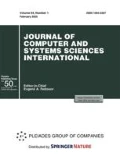Abstract
The article considers the practical application of the analysis and estimation of the controlled Markov jump process states by continuous, discrete, and counting observations in the development of state monitoring algorithms for network connections operating under the Transmission Control Protocol (TCP). A specific feature of the applied problem is the physical heterogeneity of the channel providing the TCP connection under study: along with the wired section, there is a wireless “last mile” of the channel. The current state of the entire connection cannot be directly observed, and there is just indirect statistical information in the form of a flow of acknowledgements of successful packet transmission, as well as packet loss counting processes and timeouts. In this part of the work, not only the controlled stochastic dynamic observation system was used for the mathematical description of the TCP New Reno connection but also the developed high-precision algorithm for tracking this connection state according to the available statistical information. The numerical examples make it possible to define causes of channel losses, such as congestion in the wired section or signal attenuation in the wireless section, and as a result modify the TCP algorithm so as to significantly increase the bandwidth.









Similar content being viewed by others
REFERENCES
D. Kurose and K. Ross, Computer Networking: A Top-Down Approach, 7th ed. (Pearson, Upper Saddle River, NJ, 2016).
E. Altman, K. Avrachenkov, and C. Barakat, “TCP in presence of bursty losses,” Perform. Evaluat. 42, 129–147 (2000).
E. Yariv and N. Merhav, “Hidden Markov processes,” IEEE Trans. Inform. Theory 48, 1518–1569 (2002).
A. V. Borisov and G. B. Miller, “Analysis and filtration of special discrete-time Markov processes. II. Optimal filtration,” Autom. Remote Control 66, 1125 (2005).
A. V. Borisov, A. V. Bosov, and G. B. Miller, “Modeling and monitoring of VoIP connection,” Inform. Primen. 10 (2), 2–13 (2016).
G. Haßlinger and O. Hohlfeld, “The Gilbert-Elliott model for packet loss in real time services on the internet,” in Proceedings of the 14th GI/ITG Conference on Measurement, Modelling and Evaluation of Computer and Communication Systems MMB, Dortmund, Germany, 2008, pp. 269–283.
L. Kleinrock, Queueing Systems II: Computer Applications (Wiley Interscience, New York, 1976).
D. P. Bertsekas and R. G. Gallager, Data Networks (Prentice-Hall, New Jersey, 1992).
G. P. Basharin, Lectures on Mathematical Theory of Teletraffic (Ross. Univ. Druzhby Narodov, Moscow, 2004) [in Russian].
V. Misra, W. Gong, and D. F. Towsley, “Fluid-based analysis of network of AQM routers supporting TCP flows with an application to RED,” ACM SIGCOMM Comput. Commun. Rev. 30, 151–160 (2000).
W. Whitt, Stochastic-Process Limits, An Introduction to Stochastic-Process Limits and their Application to Queues (Springer, New York, 2002).
J. Domanska, A. Domanski, T. Czachorski, and J. Klamka, “Fluid flow approximation of time-limited TCP/UDP/XCP streams,” Bull. Polish Acad. Sci.: Tech. Sci. 62, 217–225 (2014).
H. Kushner, Heavy Traffic Analysis of Controlled Queueing and Communication Networks (Springer, New York, 2001).
W. E. Leland, M. S. Taqqu, W. Willinger, and D. V. Wilson, “On the self-similar nature of ethernet traffic,” IEEE/ACM Trans. Networking 2, 1–15 (1994).
M. E. Crovella and A. Bestavros, “Self-similarity in world wide web traffic: evidence and possible causes,” IEEE/ACM Trans. Networking 5, 835–846 (1997).
B. Tsybakov and N. Georganas, “Overflow and losses in a network queue with a selfsimilar input,” Queueing Syst. 35, 201–235 (2000).
T. Mikosch, S. Resnick, H. Rootzen, and A. Stegeman, “Is network traffic appriximated by stable Levy motion or fractional Brownian motion?,” Ann. Appl. Probab. 12, 23–68 (2002).
E. Altman, T. Boulogne, R. El Azouzi, T. Jimenez, and L. Wynter, “A survey on networking games,” Comput. Operat. Res. 33, 286–311 (2006).
K. J. R. Liu and B. Wang, Cognitive Radio Networking and Security: A Game-Theoretic View (Cambridge Univ. Press, Cambridge, 2010).
O. Habachi, R. El-Azouzi, and Y. A. Hayel, “Stackelberg model for opportunistic sensing in cognitive radio networks,” IEEE Trans. Wireless Commun. 12, 2148–2159 (2013).
S. Liu, T. Basar, and R. Srikant, “TCP-Illinois: a loss and delay-based congestion control algorithm for high-speed networks,” Perform Evaluat. 65, 417–440 (2008).
S. Mascolo and G. Racanelli, “Testing TCP westwood+ over transatlantic links at 10 gigabit/second rate,” in Proceedings of the 3rd International Workshop on Protocols for Fast Long-Distance Networks FLDNET05, Lyon, France, 2005.
C. Caini and R. Firrincieli, “TCP hybla: a TCP enhancement for heterogeneous networks,” Int. J. Satellite Commun. Networking 22, 547–566 (2004).
S. Ha, I. Rhee, and L. Xu, “CUBIC: a new TCP-friendly high-speed TCP variant,” ACM SIGOPS Operat. Syst. Rev. 42 (5), 64–74 (2008).
N. Cardwell, Y. Cheng, C. S. Gunn, S. H. Yeganeh, and V. Jacobson, “BBR: congestion-based congestion control,” ACM Queue 14 (5), 20–53 (2016).
A. V. Borisov, G. B. Miller, and A. I. Stefanovich, “Controllable Markov jump processes. I. Optimum filtering based on complex observations,” J. Comput. Syst. Sci. Int. 57 (6) (2018, in press).
S. Floyd and V. Jacobson, “Random early detection gateways for congestion avoidance,” IEEE/ACM Trans. Networking 1, 397–413 (1993).
B. M. Miller, K. E. Avrachenkov, K. V. Stepanyan, and G. B. Miller, “The problem of optimal stochastic data flow control based upon incomplete information,” Probl. Inform. Transmiss. 41, 150 (2005).
E. B. Dynkin, Markov Processes (Fizmatgiz, Moscow, 1959; Springer, Berlin, Heidelberg, 1965).
J. C. Cox and V. Smith, Recovery Theory (Sov. Radio, Moscow, 1967) [in Russian].
A. A. Borovkov, Asymptotic Methods in Queueing Theory, Probability and Mathematical Statistics (Fizmatlit, Moscow, 1980; Wiley, New York, 1984).
http://www.isi.edu/nsnam/ns/.
ACKNOWLEDGMENTS
This work was supported by the Russian Foundation for Basic Research (grant no. 16-07-00677).
Author information
Authors and Affiliations
Corresponding author
Additional information
Translated by A. Kolemesin
Rights and permissions
About this article
Cite this article
Borisov, A.V., Miller, G.B. & Stefanovich, A.I. Controllable Markov Jump Processes. II. Monitoring and Optimization of TCP Connections. J. Comput. Syst. Sci. Int. 58, 12–28 (2019). https://doi.org/10.1134/S1064230719010040
Received:
Accepted:
Published:
Issue Date:
DOI: https://doi.org/10.1134/S1064230719010040




